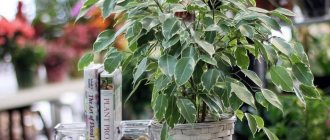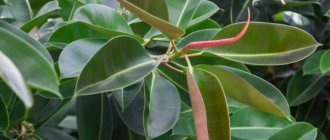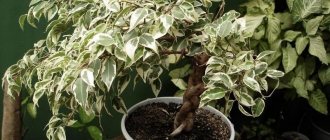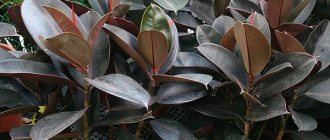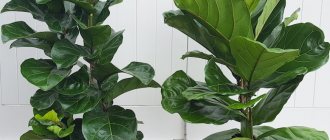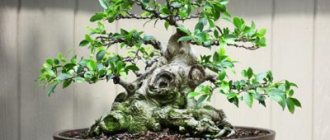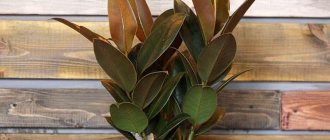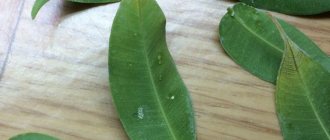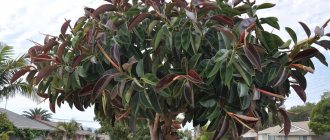Inexperienced flower growers, meeting this plant for the first time, may not recognize it as a ficus, but few of them will refuse to see it on their windowsill. Ficus Ali (Alii or Ficus Binnendijkii) is an evergreen tree of the Mulberry family. It grows naturally in Asian countries. Among all the varieties of the genus, it is the one most often chosen for landscaping residential premises and offices.
Appearance and varieties
Under the names “Ficus Ali” or “Ficus Binnendijka” there is a whole group of plants that look similar to each other. In the 19th century, they were discovered and described by the Dutch gardener and botanist Simon Binnendijk. "Nakhodka" was subsequently named in his honor, and the name was later simplified colloquially to "Binnedick Ali", "Benedict Ali" and "Binnendick". That is, to be more specific, Ali is a miniature indoor variety of a huge willow tree brought to Europe from the Asian tropics. Sometimes it is mistakenly considered a variety of Ficus Benjamin, but as is easy to see from its appearance, these are different plants.
The most popular domesticated varieties (cultivars) of ficus Binnendieck are:
- Ficus Ali (Ficus Binnendijkii cv. Alii). Differs in leaves that are slightly wider than those of Ficus Binnendijkii. The most cultivated variety at home among all other Bennendickians.
Ficus Binnendijkii Alii - Ficus Ali Amstel Green Gold (Ficus Binnendijkii cv. Amstel Green Gold). The narrow leaves of this variegated variety have a very beautiful and original color: on a yellow-green background, spots of different configurations and different shades of green are randomly located. This cultivar is sometimes also called “Variegata” (syn. Ficus binnendijkii Variegata).
Ficus Binnendijkii Amstel Green Gold - Ficus Amstel King (Ficus Binnendijkii cv. Amstel King). Large-leaved variety. The width of its leaves is up to 7 cm.
Ficus Binnendijkii Amstel King - Ficus Amstel Queen (Ficus Binnendijkii cv. Amstel Queen). The leaves of this exotic are slightly wider than those of Ali, but narrower than those of Amstel King. The bark may take on a reddish tint.
Ficus Binnendijkii Amstel Queen
In their natural habitat, in the tropical forests of Southeast Asia, Binnendijk ficuses are evergreen trees that grow up to 15-20 meters. In indoor conditions, these are small trees, the height of which is rarely higher than 2 meters. Their bark is smooth, with white streaks; in young specimens it is dark brown, in adults it is white-gray.
If we talk about how this ficus blooms, then it should be noted that it is very difficult to achieve its flowering at home. There are not enough pollinating insects to set seeds. In nature, it is observed every spring. The flowers themselves, which can be male or female, do not look like a flower in the usual sense. They look like growths on the bark.
The main reason for the difficulties that you may encounter when identifying a variety is the unusual shape of the leaves. In Ficus Ali they are long (up to 30 cm in length) and narrow (5-7 cm in width), reminiscent of willow leaves, which is why people often call it “ficus willow”. The color of the foliage depends on the variety and its habitat and can be variegated (variegated) or monochromatic. Veins run through the center, refracting the leaves in the middle, so that in appearance they resemble open pea pods. The green mass is very thick, so the branches sink downwards under its weight, as if they were “crying”.
Description of the plant
Ficus Ali is a plant that does not look too much like a ficus, which misleads many people. However, despite its peculiar appearance, it is still a domestic long-leaved ficus. Why is this ficus bin Ali so different from other ficuses?
It's all about the leaves of this variety. While most ficus plants have large, dense, and oval-shaped leaves, this species has leaves that are long and narrow. These narrow leaves reach about 30 cm in length. Different varieties of this home ficus have leaves that are equally long, but can have different colors. Due to these features, this plant is also called “ficus willow”.
This culture looks slightly unusual compared to other ficuses. In the wild, Ficus Binnendijka can reach fifteen meters in height. The narrow leaves have a pointed shape at the ends. The color of the leaves directly depends on the ficus variety, as well as external conditions. It can be monochromatic or variegated. The leaves have a clear longitudinal vein. It bends the sheet into two parts, as if creating a natural break.
Among gardening experts it is customary to call this species “ficus ficus”. However, this is a colloquial name and not an official one.
This flower does not require complex care. It will grow and delight you with its beauty, adding subtle tropical freshness to the atmosphere of the room, and comfort and novelty to the interior.
The maximum length of the leaves is up to thirty centimeters, and the width is from 5 to 7. The leaf has a characteristic bright vein, and its color depends on the variety: there are both plain and variegated specimens.
Among domesticated ficus trees there are rare varieties that require special maintenance conditions.
In nature, this evergreen plant reaches a height of 15–20 meters. It is similar to a tree, as it has an even and fairly long trunk. It is covered with bark, which in adult specimens has a dark tint. There are pale stains on its surface.
The narrow, belt-like leaves have pointed tips. The branches of this ficus are drooping.
The leaf has a brightly visible vein that runs along it. Lateral veins diverge in different directions from the central vein, which are not so clearly visible. And the central vein bends the leaf in half, as if breaking it.
Additional Information! This plant is considered poisonous to pets. It causes stomach upset.
Ficus Ali: reproduction
At home, Ficus Binnendijka is propagated by stem cuttings. Propagation material is best collected from an adult tree in spring and summer. Before propagating Ficus Ali - using a sharp knife or pruning shears to cut 15-20 cm long cuttings from the stems of the mother plant, you need to prepare water and a container for their rooting.
The water should be settled and heated to room temperature. Any container will do, it can be a glass jar or a plastic container. The cuttings are placed in a container with water and kept in a warm room at an air temperature of 20-25 degrees, away from direct sunlight. If the room is too hot, the cuttings are sprayed with water at room temperature from a spray bottle from time to time. Water is periodically added to the container. After 1-2 weeks, the cuttings produce roots. After 3-4 weeks, when the roots reach 2-2.5 centimeters, the cuttings are planted in the soil.
Ficus trees can also be propagated by seeds. Such seeds are sold in many specialized stores. This is not the most popular method as it requires a lot of time and patience.
Growing conditions
Ficus plants are not particularly demanding in terms of living conditions in a house or apartment, however, they also have their own preferences. Compliance with them contributes not only to the preservation of the decorative appearance of the plant, but also to its healthy development.
Accommodation
Ali's species thrives in diffused light or partial shade. The best option for him would be placement on the east or southeast side.
If you plan to place it in other places, then consider the following features:
- lack of light will cause leaves to lose color;
- direct sunlight will cause burns, so when placing it on the south side, be sure to shade it;
- the plant does not tolerate changing locations well, so immediately choose a location for it taking into account its potential growth;
- the flower should not suffer from drafts.
Temperature
In addition to light, Ficus Benedict also loves warmth. In summer he will be comfortable at +22...24°C, and in winter the minimum permissible limit is +16°C.
Important! When growing a flower, remember a simple rule: the warmer the room, the more light it needs, and the cooler it is, the shorter the daylight hours are needed.
A change in air temperature in itself does not have much effect on the ficus, but a sharp change in soil temperature is critical for it. It is highly not recommended to place the pot near air conditioners in summer, and in winter, when heating devices are operating, the ficus should be kept away from them.
He loves plants and fresh air: regular ventilation of the room will do him good.
Air humidity
The humidity level is not too important for the Ali variety, but if possible it is better to maintain it at 50–70%.
On hot summer days, it will not be disturbed by periodic spraying with warm, settled water or wiping the foliage with a damp sponge. It’s great if it’s possible to place a household humidifier in the room during this time.
Features of care
This exotic green pet is not at all capricious to care for at home, it grows very quickly and can hit the ceiling just a couple of years after rooting. In order for a tree to captivate others with its well-groomed appearance, it is enough to create certain conditions for it.
The soil
The soil for ficus willow must be fertile, loose, breathable, and not retain excess moisture. Alkaline and acidic soil types are not suitable. Cuttings can be planted in ready-made soils for palm trees and ficus trees, or you can create a soil mixture yourself. To do this, you need to take 2 parts of turf, 2 parts of rotted leaves, one part each of sand, humus and peat.
Feeding
Fertilizers should be applied in the spring and summer months, alternating mineral and organic. Twice a month, you can add complex fertilizer intended for indoor flowers to the water for irrigation. With the same regularity, you can spray the leaves with a weak solution for feeding. During the dormant period (late autumn and winter), feeding is stopped.
Microclimate
The most suitable place for Binnendijk varieties is away from direct sunlight and radiators. The most comfortable air temperature in the room in summer is + 20 -25 ° C, in winter - + 16-20 ° C. The air in the room should not stagnate. But you cannot open a window for ventilation, near which there is a pot or tub with a tree, or hang an air conditioner over it: the ficus also does not tolerate direct drafts.
Humidity
Watering should be moderate, with settled water at room temperature. In winter, watering frequency is once a week, from spring to autumn - three times a week. Stagnation of moisture in the pot should not be allowed, this leads to rotting of the roots. It is recommended to spray the leaves regularly, especially when the air in the room is overheated.
The need for watering is determined by the condition of the soil in the pot - it should dry to a depth of 3-5 cm. If the surface layer of soil crumbles easily in your hands and does not stick, water the ficus. Water is poured on top of the earthen clod in small portions in several stages. After half an hour, the water that has flowed into the pan is drained, and the pan and the bottom of the pot are wiped dry.
Lighting
Ficus Binnendijka Ali comes from subtropical forests, so it loves good lighting. It is also noteworthy that the warmer the room, the more light it needs. In the natural habitat, this feature is associated with the change of seasons. Variegated varieties are suitable for diffused light, trees with dark green leaves are suitable for partial shade. The preferred place on the windowsill is the south or east side.
Transfer
Young trees grow quickly, and every year they need to be transplanted into a new pot 3-4 cm larger than the previous one with a complete replacement of the soil. It is advisable that the pot be new and sterile. If the container has already been used, wash it thoroughly and disinfect it. Adult plants have to be replanted less frequently, every 3 years, using the transshipment method. Very large specimens have a negative attitude towards replanting; they are left in place, but the top layer of soil must be renewed every year.
The best time for replanting is the beginning of spring, when the tree awakens from dormancy. Drainage is poured into the bottom of the pot. A ficus is placed on it, and soil is evenly poured around it on all sides. This is done regardless of whether the tree is replanted with a complete replacement of the soil or by transshipment with a lump of root soil. You need to carefully ensure that the barrel stands up straight, without tilting in any direction. Then the soil in the pot is watered abundantly, and the transplanted plant is placed in its original place. Subsequent watering is carried out as the soil dries.
Ficus Ali does not like to be moved or turned, he is a “homebody”, so you must immediately look for a place for him in the room, taking into account his future growth.
Pruning ficus Binnendijka
Caring for indoor ficus includes mandatory formative pruning. Without it, it will grow chaotically and lose its decorative effect. In order for the exotic grown at home or in the office to acquire a permanent shape, you need to start pruning it from an early age, when the stems remain flexible. The best time for a haircut is spring. During this period, the green pet has a large supply of vitality and is able to grow evenly, throwing out many shoots.
Thanks to pruning and shaping, the tree can take on a variety of shapes: arch, ball, bush, bonsai. Some masters give their green pets more complex configurations, which are equated to sculptures, and their creation to a kind of art - ficus weaving. This process is incredibly exciting, but requires patience and regularity.
When starting pruning, you need to take into account some nuances. New shoots are formed from apical and lateral (axillary) buds. The apical buds develop faster and slow down or even completely block the development of the lateral buds. Pruning the apical bud during the period of its active growth (in spring) entails the active awakening of the axillary buds, from which shoots, in turn, begin to actively grow.
Autumn-winter pruning carries the risk of one-sided development and the ficus will grow skewed. In addition, in autumn and winter, ficus uses nutrients accumulated in the above-ground parts during the period of active growth, and pruning deprives the plant of these reserves.
Crown formation is not only about pruning, but about directing the shoots in the right direction. This is done using all kinds of devices. Therefore, before cutting off the shoot, it needs to be directed and fixed. After some time, the fixing device is removed.
Pruning is carried out with a sharp knife or pruning shears in the following order:
- remove the shoot above the bud;
- the cut area is blotted with a sponge until the milky juice stops secreting;
- The “wound” is disinfected with charcoal or activated carbon powder.
It is not recommended to leave stumps when pruning, as this can lead to disease.
The trunks can also be given interesting shapes by intertwining them with each other. To do this, 2-3 cuttings are planted in one pot. A pair of plants is formed into spirals by twisting the stems. Of the three, they braid a pigtail. Weaving is done freely so that the growth of the tree does not stop. Excess shoots and leaves are removed.
Diseases and pests
The question of what to do if the ficus gets sick or is attacked by pests is relevant, despite the fact that such troubles rarely happen with willow-leaved specimens. We list the main ones:
- The leaves droop and fall. A common cause is excessive soil moisture and root rotting.
- The development of the ficus has slowed down and it is shedding its leaves. This often happens due to lack of light.
- The foliage wrinkles and dries out. This is often the result of direct sunlight hitting the crown. She needs to be shaded.
- Brown spots appear on the edges of the leaves. The reasons may be different: excessive amounts of fertilizer, dry air, high room temperature.
If not carefully cared for, the Binnendijka variety can be attacked by pests. The most common among them:
- Scale insects and false scale insects. Infection is manifested by loss of color and loss of leaves. On it you can see insects that look like black plaques. To remove them, wipe the leaves with a soft cloth soaked in soapy water.
- Spider mite. Its appearance can be easily determined by the thinnest cobwebs on the leaves, similar to a white coating. To get rid of a mite, you need to rinse the plant in the shower several times with a break a week to increase humidity. Spider mites cannot tolerate it.
Main varieties
All varieties are very similar in appearance and differ only in the width and color of the leaves. Ficus Ali has the widest leaf blade.
Ficus ali
More often than others you can find it in interior design . Its leaf blades have slight differences from other varieties due to the slightly increased leaf width. This gives the ficus a certain grace, which is readily used by breeders to decorate the facades of buildings and premises;
Amstel King
It has a spherical crown and uniform dark green leaf color. The main difference from other varieties is the width of the leaf blade is 7 cm.
Amstel Gold
The leaves of Amstel Gold immediately stand out: the colors are scattered along the entire length and shimmer from yellow-green to light green. Areas of different shades are located chaotically.
This spectacular color is called “variegated” or “spotted”, formed due to the presence of mutant cells that do not synthesize chlorophyll.
Amstel Queen
The variety is practically indistinguishable from Amstel King - the leaves are only slightly wider and occupy an intermediate position between King and Ali.
Useful properties of ficus Ali for humans
Different nations associate all sorts of signs and superstitions with the presence of ficus in the house. In Asian countries, they believe that this tree is the patron of the home, helps solve family financial problems, strengthens marital unions, and helps childless women get pregnant. The Slavs, on the contrary, often have a negative attitude towards ficus, considering it a “husband” - a homewrecker.
Whether this is true or not, we do not undertake to judge. In any case, it is incorrect to consider ficus growing in the house only as a decorative decoration of the space. It can bring a lot of benefits to a person:
- purify indoor air, saturating it with oxygen and converting harmful substances into amino acids;
- serve as energy protection for the inhabitants of the house;
- be the basis for the preparation of decoctions and alcohol tinctures that help with diseases of the joints, oral cavity, hematomas, and female genital area.
There is also an opinion that ficus is poisonous. Indeed, since this tree is a rubber tree, its milky sap contains rubber. If it comes into contact with the skin, it may cause itching and irritation. Therefore, it is better to carry out all work with gloves, and also place the pot with it out of the reach of small children and animals.
Growing Ficus Ali is easy and interesting: easy to care for, it delights with lush and bright foliage. It also gives flower growers the opportunity to show their creative talents by creating green sculptures of various shapes on their own windowsill. Flower growers who cultivate this exotic plant in their homes leave positive reviews about it and receive only positive emotions from “communication” with it.
Crown formation
Ficus Ali and caring for it also involves the formation of the crown. You can make a bonsai tree from ficus trees. You can also combine several similar varieties together: Amstel King, Benjamin and Gold. Ficus variety Benedict Ali grows like the most common tree, but if the crown is very bushy, it is cut off. Ficus variety Ali leaves are long and therefore well formed.
Pruning will not harm the plant, the flower will not lose its size, on the contrary, it is a way to help it grow and develop. The crown is also formed from several ficus plants grown in one pot. This is possible thanks to the stem, because it is thin and several pieces can intertwine with each other without any effort, like a woman’s braid.

